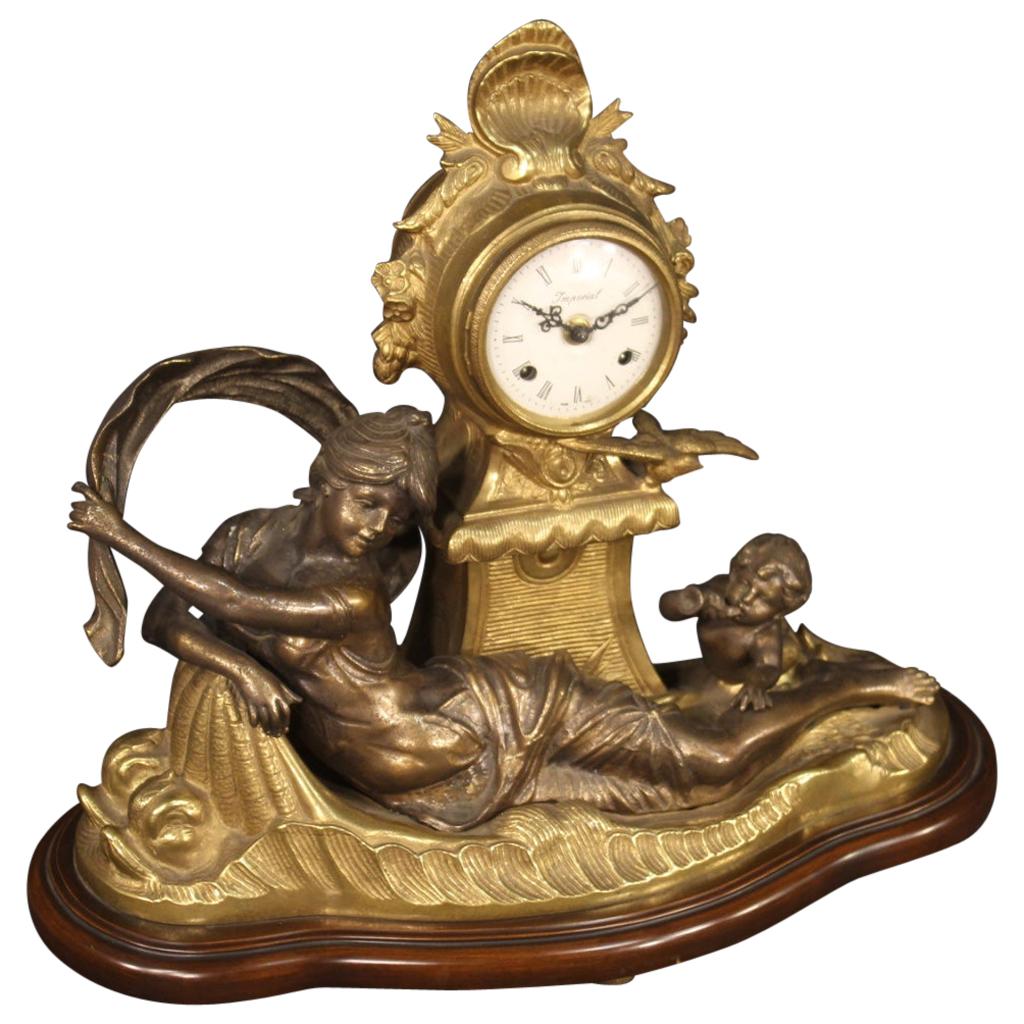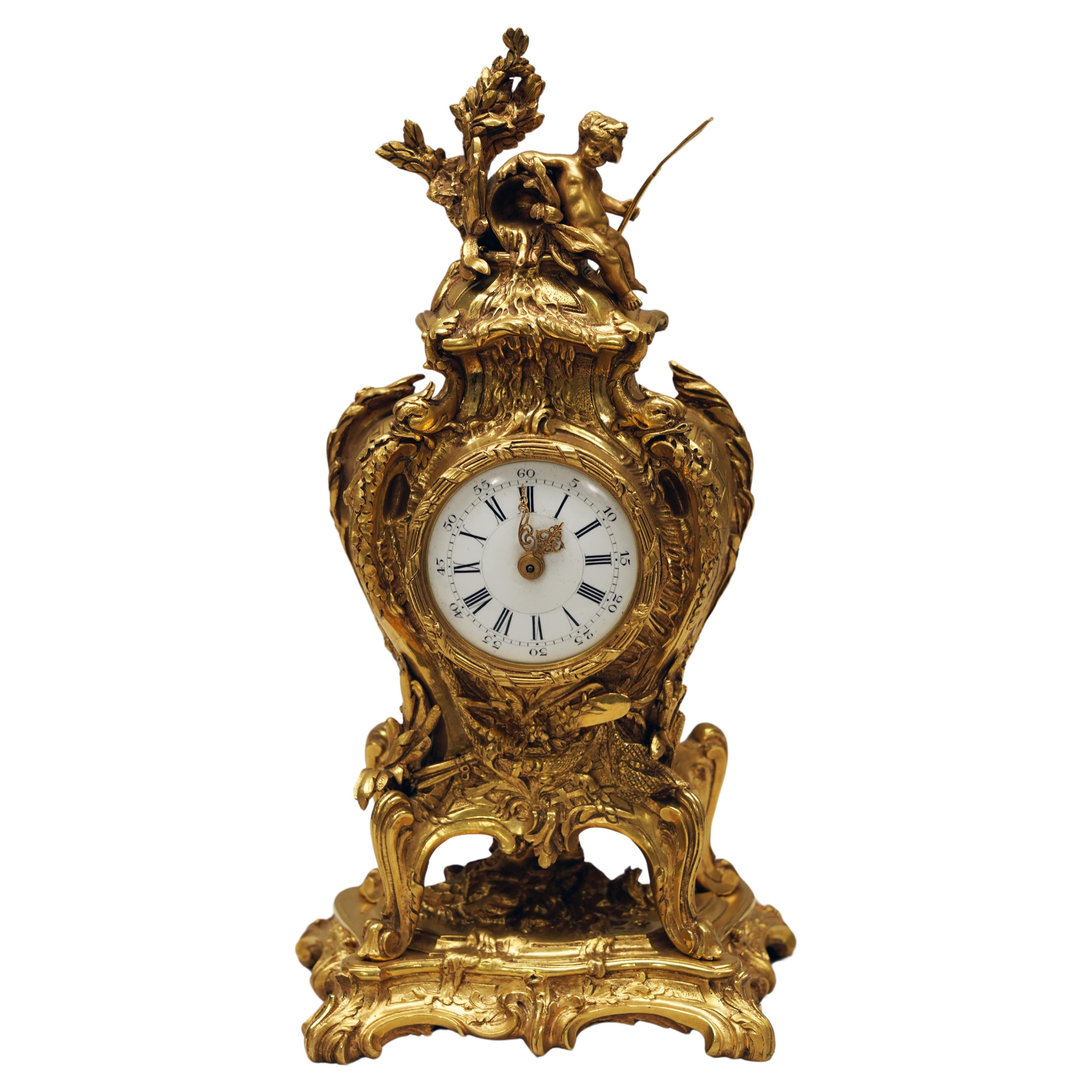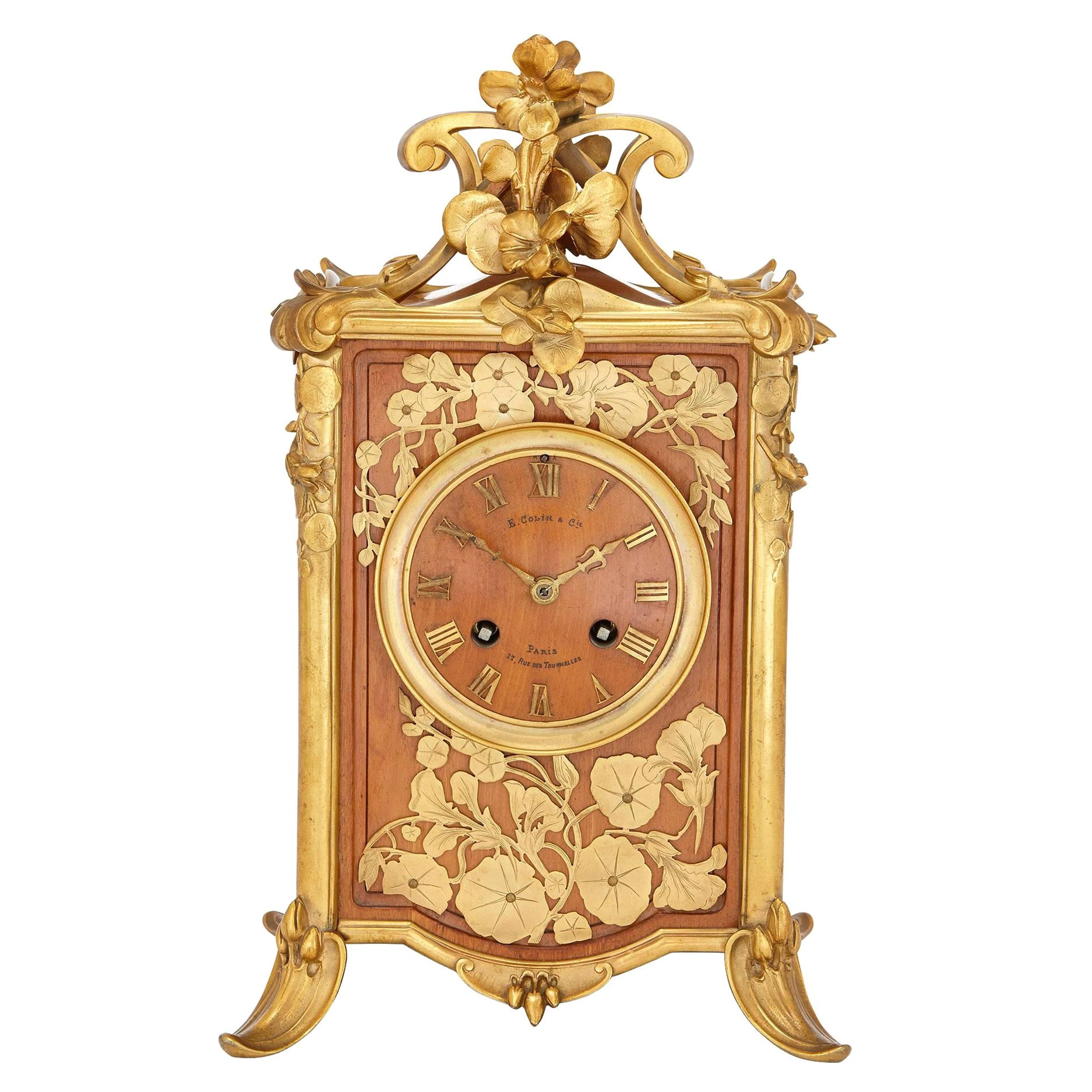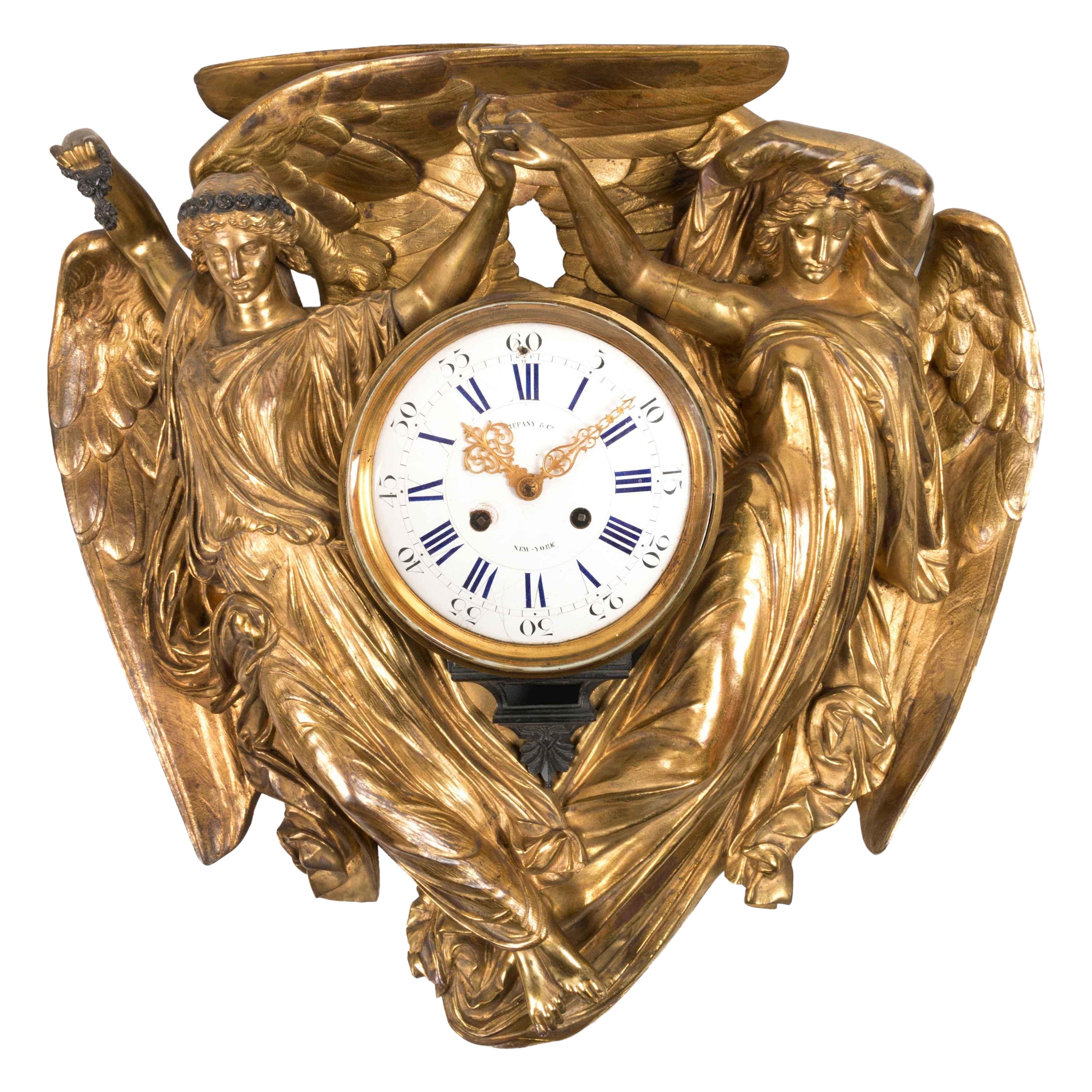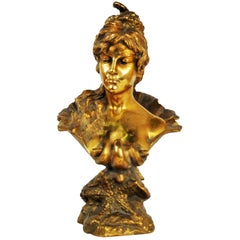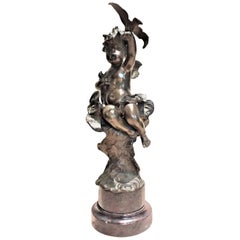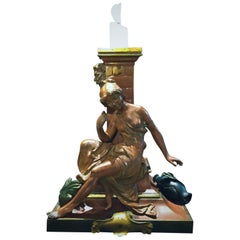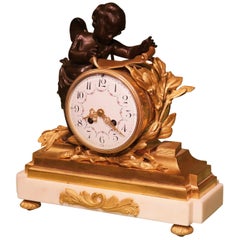Items Similar to Max Blondat, French Art Nouveau Gilt Bronze Timepiece, 1914
Want more images or videos?
Request additional images or videos from the seller
1 of 11
Max Blondat, French Art Nouveau Gilt Bronze Timepiece, 1914
$6,337.50
$9,75035% Off
£4,813.49
£7,405.3735% Off
€5,561.17
€8,555.6435% Off
CA$8,882.24
CA$13,664.9835% Off
A$9,940.89
A$15,293.6835% Off
CHF 5,188.38
CHF 7,982.1335% Off
MX$121,227.64
MX$186,504.0535% Off
NOK 66,404.22
NOK 102,160.3435% Off
SEK 62,860.10
SEK 96,707.8535% Off
DKK 41,502.26
DKK 63,849.6335% Off
Shipping
Retrieving quote...The 1stDibs Promise:
Authenticity Guarantee,
Money-Back Guarantee,
24-Hour Cancellation
About the Item
"L'amour Non Partagé" or "Unrequited Love", an allegorical timepiece by Max Blondat. The base of the clock is stamped with the artist name "Max Blondat", and carries a Valsuani foundry stamp with “CIRE at the top "PERDUE" at bottom (Cire Perdue is French for lost wax casting), as well as copyright symbol and date "02.1914".
It is rare to find a stunning work of art of museum quality and craftsmanship, such as this beautiful and important bronze sculptural timepiece. Like all Max Blondat's sculptural compositions, this one also features the originality and allegory of a specific theme. In this particular case, it is unrequited love. The body of the clock is in the form of a luscious three-dimensional heart embroidered with flowers. In the center of the front part a clockwork with porcelain face and enameled hour hands are mounted. There are several feathers of arrows piercing the bronze frame dial by the upper part of the perimeter, indicating the repeated unsuccessful attempts of the stubborn lover to succeed in this field with his impregnable vis-à-vis, who does not at all want to respond to loving appeals with reciprocity. In the foreground, a charming chubby Cupid bent down in thought and apparent helplessness. Having lost all hope and lowering his bow, he holds in his hand a broken arrow, the second fragment of which is lying under his feet. And, while he is frozen in thought, time passes and the clock is ticking! Naturally, the observer has a question: "And how, in fact, does this sad unrequited love story end? Will Cupid achieve desired reciprocity over time and, showing constant perseverance, break inaccessibility?" Looking at the cover in the form of several crossed arrows, defending the clockwork at the back of the clock very reliably, the answer to this question arises by itself - and, this answer is "No!”
Maximilian Blondat (1872-1926), or Max Blondat was a French sculptor of Art Nouveau and Art Deco styles. One of his most famous sculptures is the Fountain of Youth, representing three children watching three frogs. Copies are at the Place Darcy in Fontainebleau; Düsseldorf, Germany; Buenos Aires, Argentina; Ukraine, Odessa; Zurich, Switzerland, and the United States in Denver. He was the son of a copper worker and was apprenticed to an ornamentalist sculptor in 1886. Blondat continued over the sculpture work in many areas and different materials. He arrived in Paris and began his studies in 1889 at the Ecole Germain Pilon. In 1890, he exhibited at the Salon of French artists for the first time and presented a plaster medallion, then perfected in the workshop of Mathurin Moreau . In 1892 , he entered the École des Beaux-Arts in Paris. During that period, Max Blondat signed his first achievements using the maternal family name Henry . His works can be found in wood, stone, clay, glass, bronze, and he excelled in the decorative arts with the reduction of his sculptures and the creation of small utilitarian objects: car radiator caps, knockers, clocks, pockets, ashtrays etc. He also produced ceramics with Edmond Lachenal AT the Sèvres manufactory, and worked extensively with wrought iron with Edgar Brandt . His bronzes had been cast by the Siot-Decauville and Valsuani foundries . Blondat also created jewelry for Chambon and Hermes . In 1906, he became a founding member of the Society of French Decorative Arts . Part of his work is on display at the Museum of the 1930's in Boulogne-Billancourt . One of his most famous creations is the Fountain of Youth, representing three children observing three frogs. The exact copies of the fountain can be seen in Dijon Darcy, Fontainebleau, as well as in Dusseldorf , Germany; Buenos Aires, Argentina; Odessa, Ukraine; Zurich, Switzerland; Zurich, Switzerland; and Denver, United States. Engaged in the service of camouflage (the Chameleon) which he left in 1917 for becoming a head of the École des Beaux-Arts in Dijon, where he served until 1919. He then got carried away by creation of the WWI memorials. Maximilian Blondat was decorated with the Cross of War (WWI, 1914-1918) and made an officer of the Legion of Honour in 1925. He lived in the neighborhood of the Parc des Princes in Boulogne-Billancourt, a city which gave his name to one of its streets. A street in another small French town of Auxerre bears his name, as well.
Valsuani Foundry (1899 – circa 1977) was started by the Italian brothers Claude and Attilio Valsuani who learned the foundry trade while employed at the famous Hébrard art foundry. While working for Hébrard, Claude Valsuani showed great promise as a finisher and eventually worked his way up to become the Technical Director of the Hébrard foundry. In 1899 Claude Valsuani started his own foundry in Châtillon, casting mostly small works for various artists primarily using the lost wax technique of casting (cire perdue). In 1905 he moved his foundry to 74, rue des Plantes in Paris. Among the better known sculptors who had the Valsuani foundry cast their works were: Degas, Rodin, Renoir, Gauguin, Maillol, Picasso, Modigliani, Matisse, Giacometti, Brancusi. Ossip Zadkine also used this foundry for the casting of his sculptures. Thus, the Valsuani foundry quickly acquired a great reputation, particularly for its outstanding mastery of lost wax casting. Claude Valsuani was also celebrated for the beautiful patinas he created with a blowtorch, a technique imported from Italy which, as he said, did not leave any deposit of carbon and gave the sculptures a beautiful glossy aspect. One of the foundry’s most famous patinas until now is called the Noir de Valsuani (Valsuani black). Last but not least, Claude Valsuani was among the first casters to fight against counterfeiting and unauthorized editions by marking each sculpture with the total number of casts in a series, as part of his numerical notation (eg. 1/10). Claude Valsuani died in 1923 in his native Italy, but his son, Marcel took over the running of the foundry and continued to produce extremely fine detailed bronzes until the 1970s.
- Creator:Max Blondat (Sculptor)
- Dimensions:Height: 11.75 in (29.85 cm)Width: 8.5 in (21.59 cm)Depth: 5 in (12.7 cm)
- Style:Art Nouveau (Of the Period)
- Materials and Techniques:
- Place of Origin:
- Period:1910-1919
- Date of Manufacture:1914
- Condition:Wear consistent with age and use.
- Seller Location:New York, NY
- Reference Number:1stDibs: LU281938358243
About the Seller
5.0
Vetted Professional Seller
Every seller passes strict standards for authenticity and reliability
Established in 1993
1stDibs seller since 2017
81 sales on 1stDibs
Typical response time: 11 hours
- ShippingRetrieving quote...Shipping from: New York, NY
- Return Policy
Authenticity Guarantee
In the unlikely event there’s an issue with an item’s authenticity, contact us within 1 year for a full refund. DetailsMoney-Back Guarantee
If your item is not as described, is damaged in transit, or does not arrive, contact us within 7 days for a full refund. Details24-Hour Cancellation
You have a 24-hour grace period in which to reconsider your purchase, with no questions asked.Vetted Professional Sellers
Our world-class sellers must adhere to strict standards for service and quality, maintaining the integrity of our listings.Price-Match Guarantee
If you find that a seller listed the same item for a lower price elsewhere, we’ll match it.Trusted Global Delivery
Our best-in-class carrier network provides specialized shipping options worldwide, including custom delivery.More From This Seller
View AllZenith Watch Co., Swiss Art Deco Metal Dore and Cloisonne Enamel Clock, 1920s
Located in New York, NY
Zenith SA is a Swiss luxury watchmaker. The company was started in 1865 by Georges Favre-Jacot at the age of 22, in Le Locle in the canton of Neuchâtel. Zenith w...
Category
Vintage 1920s Swiss Art Deco Table Clocks and Desk Clocks
Materials
Metal
$1,080 Sale Price
20% Off
French Art Nouveau, Female Bust, Gilt Bronze, 1900s
Located in New York, NY
Signed under the left shoulder: ”CerNelille”.
Category
Antique Early 1900s French Art Nouveau Busts
Materials
Bronze
French Belle Époque, Patinated Bronze Desktop Sculptural Paperweight, 19 Century
Located in New York, NY
Signed illegibly original red marble base.
Dimensions: H: 8.25” x W: 3.25” x D: 4.25” Base diameter: 2.75”
This beautiful and delicate desktop dark chocolate-brown patinated br...
Category
Antique 1870s French Belle Époque Paperweights
Materials
Marble, Bronze
La Cruche Casee, Antique French Bronze Sculptural Desk Candleholder, circa 1875
Located in New York, NY
The inscription engraved on the gilded medallion in the center of the plinth serves as the name of this remarkable sculpture, La Cruche Casee (The Broken Jug). Made of multicolored patinated and ormolu bronze in the second half of the 19th century France, this absolutely fabulous stationary figural candle...
Category
Antique 1870s French Romantic More Candle Holders
Materials
Bronze
Charles Vital-Cornu, French Art Nouveau Bronze Sculptural Floral Vase, 1900s
By Charles Vital-Cornu
Located in New York, NY
Charles Vital-Cornu (French, 1851 - 1927), Jouffroy’s and Pils’ pupil, he acquired a skillfulness mastery in carving marbles and producing bronzes. He used several patinas in his production. Indeed, if his pieces' embodiments are often golden-brown colored, the hollow part are darker. His figures, hands, faces, and bodies are of a great quality.
Charles Vital-Cornu had participated in numerous annual ‘‘Salons’’ organized in Paris by ‘‘la Société des Artistes Français’’ where he got several awards, such as a mention of Honor in 1880 and 1881, a third class medal in 1882, a travelling grant in 1883, a second class medal in 1886, a bronze medal at the 1889 World Fair and, finally, a silver medal at the 1900 World Fair at the Grand palace...
Category
Antique Early 1900s French Art Nouveau Vases
Materials
Bronze
$4,675 Sale Price
44% Off
Art Nouveau Sculptural Gilded Vienna Bronze Candy Bowl, ca. 1900
Located in New York, NY
Probably, Austrian, this very original Art Nouveau orientalist sculptural candy bowl made of gilded Viennese bronze, depicts a young street vendor in bloomers and a fez, holding a hu...
Category
Antique Early 1900s Austrian Art Nouveau Decorative Bowls
Materials
Bronze
You May Also Like
20th Century Gilt Bronze and Antimony French Table Clock, 1930
Located in Vicoforte, Piedmont
French clock from the first half of the 20th century. Gilt bronze and antimony object, patinated and chiseled adorned with sculptures, mahogany-colored lacquered wooden base. Clock s...
Category
Mid-20th Century French Table Clocks and Desk Clocks
Materials
Bronze
19th Century French Bronze and Ormolu Clock Garniture
By A.D. Mougin
Located in London, GB
A fine quality late 19th century French bronze and ormolu garniture, the 8-day striking enamelled dial movement by AD Mougin - Paris, contained in ormolu cas...
Category
Antique Late 19th Century French More Clocks
Materials
Marble, Bronze, Ormolu
Vintage Mid-19th Century French Gilt Bronze and Enamel Boudoir Clock
Located in Bronx, NY
This late 19th century French boudoir clock is designed with an ornate gilt bronze scrolled frame. Within the frame of this vintage timepiece is a wonderful hand painted and signed e...
Category
Antique Late 19th Century French Art Nouveau Table Clocks and Desk Clocks
Materials
Bronze, Enamel
"The Source" Gilt bronze Clock attr. to L. Messagé & F.Linke, France, circa 1890
By François Linke
Located in PARIS, FR
Charming clock in the shape of a Rocaille-inspired cartel in chiseled and gilded bronze. Scalloped marine-inspired decor representing a trophy with oars, dolphins, reeds and flowers ...
Category
Antique 1890s French Rococo Revival Table Clocks and Desk Clocks
Materials
Bronze, Enamel
Art Nouveau Period Gilt Bronze Mounted Wooden Mantel Clock by Colin & Cie
By E. Colin & Cie 1
Located in London, GB
This elegant antique mantel clock is of the Art Nouveau period, and is set within a fine rectangular wooden case embellished with gilt bronze (ormolu) borders and floral decorations.
The clock was made by renowned Parisian maker E. Colin & Cie, and its central circular wooden dial...
Category
Early 20th Century French Art Nouveau Mantel Clocks
Materials
Bronze
Tiffany & Co. Neoclassical Gilt Bronze Wall Clock by Louis Valentin
Located in Atlanta, GA
A Tiffany & Co. neoclassical gilt bronze wall clock "Day & Night" by Louis Valentin Elias Robert (French, 1821-1874)
Retailed by Tiffany & Co....
Category
Antique 1850s French Neoclassical Wall Clocks
Materials
Bronze
More Ways To Browse
Max Bronze
L Art France Bronze
French Gilt Bronze Frame
Art Nouveau Bronze Gilt
Art Nouveau Bronze Germany
French Gold Cross Antique
Salon Des Beaux Arts Bronze
Worker Bronze
Art Nouveau Style Desk
Iron Bronze Table French
Cast Iron Desk
Bronze Hermes
1930 Antique Desk
French Bronze Sculpture And Clock
Art Deco Plant Table
1910 Clock
German Wood Clock
Used Trading Desk
